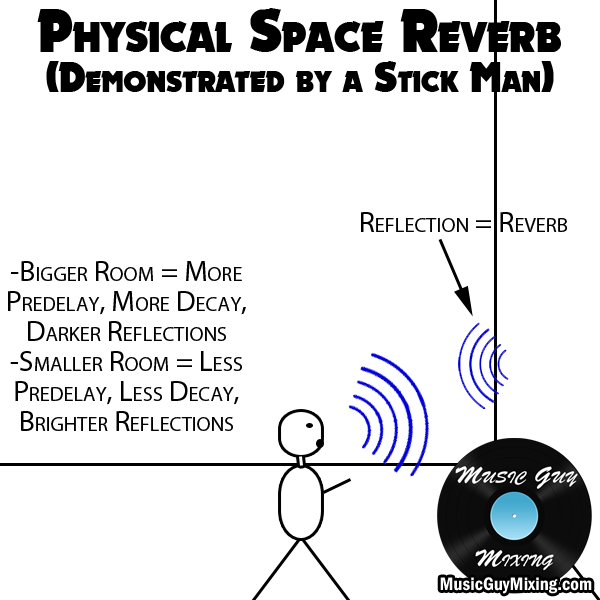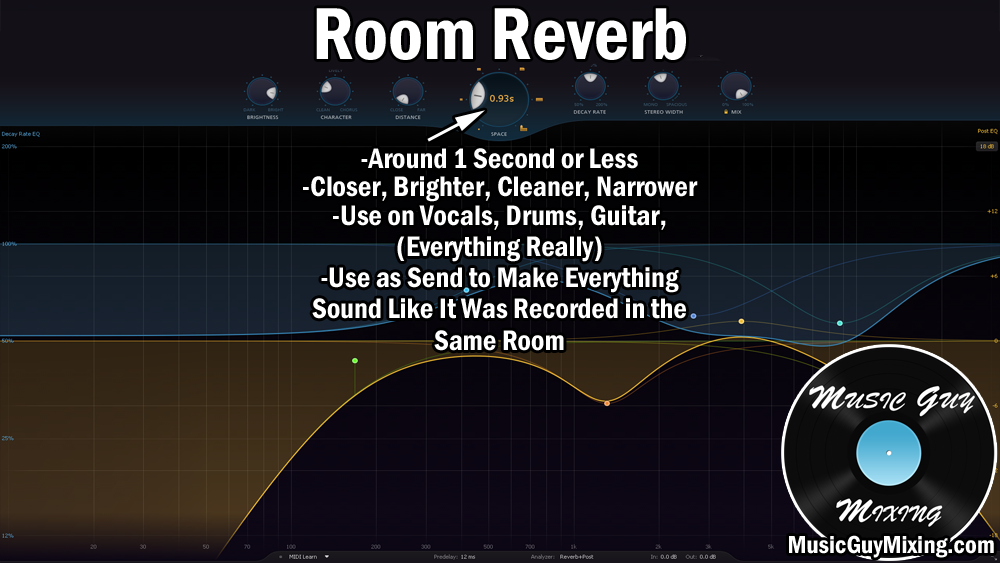Reverb is one of the most fun effects to use in mixing. Not only do they make your tracks sound cool, they bring your mix to life by making it three-dimensional. There are different types of reverb, though, ranging from small to massive and natural to artificial. Each type has a different purpose and is typically best matched with particular instruments.
Let’s define the 3 types of reverb and more importantly identify which instruments you should be using them on.
What is Reverb
Before we get into the types of reverb, we should probably explain what reverb is and what it does.
To explain it as simply as possible, reverb is the reflection of sound off of surfaces. Any space you can create sound in, inside or outside, has surfaces which reflect sound and change the way you perceive the sound itself.

Depending on how close or far these surfaces are or even their makeup, this will color the reflections to vary the timbre of the sound substantially.
For instance, singing in a closet is going to sound substantially different to singing in a cathedral. The reflections take longer in a larger room, and the reflected sound tends to be darker and more mid and lower frequency heavy.
In the world of recording in top end studios, special recording rooms are created to capture controlled and pleasing reflections by design when recording certain instruments in.
Alternatively, small spaces for recording vocals are treated with special sound absorbing materials in order to minimize reflections and get a cleaner, more natural sounding, and dry vocal.
Reverb in Mixing
In mixing terms when we’re talking about reverb, we’re typically talking about adding an effect to a track (whether it be analog or virtual/digital) to simulate the effect of reverb.
Without spacial plugins like delay and reverb, everything in our mix sits right up front. Tracks can be panned left or right of center to create width and keep things clean.
With reverb, we create a third-dimension in our mix by unlocking depth so that tracks can feel like they’re farther back in the mix. This creates a more interesting mix, not to mention it sounds really cool.
Types of Reverbs
Getting back to the point, there are three main types of reverb.
Let’s identify each one and talk about the instruments you should be using them on.

Physical Space Reverbs
Whether you call them room, chamber, hall, cathedral, etc. reverbs, they all fall into the category of physical spaces.
These are the most natural types of reverb because they’re based on simulating reflections of actual spaces of different sizes.
As I said earlier, the bigger the space, the longer and darker the reflections. Some reverbs specifically simulate one type of space whereas others can be adjusted to simulate the full size array.
I’m partial to the FabFilter Pro-R because of its versatility, ease of use, and fact that you can replicate any type of space by adjusting a few settings.
Let’s talk more about the size of spaces you can emulate with a reverb and what instruments you might use them on.
Rooms
This is the most natural sounding of all of the reverbs because it simulates normal size rooms, the kinds we spend most of our lives in.
Think closets, bedrooms, or even slightly larger like a classroom.
Room reverbs are my most used reverbs because they add depth to a mix without sounding out of place or fake.
The reflections are shorter and more subtle so that you don’t notice them as much.
On average, reflections in a normal sized room last less than a second, they feel closer to you, sound brighter, and are more narrow in width.
What To Use Room Reverbs On

As I said, I use room reverbs the most when I’m mixing as they’re the most practical.
Create an aux/return track (see inserts vs sends) and put a reverb on it with a decay time of a second or less and adjust the tone to make it favor the mids and upper mids.
I’ve linked to this before, but you can actually set the decay time of your reverb to sync perfectly with the BPM of your track using this calculator.
Inputting your BPM, you get customized decay times to correspond with the size of room of your choosing that you want to emulate.
Once it’s set, send all of your vocals to that reverb to give them some depth. You might experiment how much you send each vocal to the room reverb. For instance, you might try blending in more reverb for a chorus vocal to make it stand out a bit more.
While a room reverb works great on vocals,you can send any instruments in your mix you feel could benefit from having a bit more depth and presence.
Regardless of which tracks you send and how much, it will help make any tracks you send to it sound more cohesive as if they were recorded in the same space, even though we’re just simulating that sense for the listener.
Chambers
Chambers are the next step up in terms of the size of space we’re emulating. Top end studios like Abbey Road and Capital Studios have constructed special chambers to get some truly beautiful natural reverb on their recordings.
We can simulate that by adding a longer decay time and a bit more darkness and thickness to the sound.
Chamber reverbs add a depth you don’t get with the room due to the longer decay time and when used in the right situations, can be exactly what you need to bring a track to life.
What to Use Chamber Reverbs On

Chamber reverbs can still be used effectively as a send and occasionally I’ll create a second aux/return track to put a longer, chamber-like reverb when I want to give my vocals a bit more presence in the mix.
The thing to be wary of is that with longer decay times, the reverb tails can easily begin stacking on one another.
As such, chamber reverbs can sound great on vocals, guitars, synths, drums, pretty much anything, so long as they’re kept in check. They especially work well in sparser and slower mixes.
Halls
Halls, cathedrals, and arena sized space reverbs simulate the largest rooms with the biggest and longest reflections.
Here we’re talking about decay times of well over 2 seconds and beyond and the reflections are much darker.
Unlike room reverbs and to a lesser extent chambers, hall reverbs do not sound natural so we’re pretty much exclusively using them for cool aesthetic effects.
What to Use Hall Reverbs On

Hall reverbs are best when used at a minimum. The increased decay times paired with thicker, deeper reflections will easily muddy up your mids (incidentally it’s one the 5 causes of a muddy mix) and smother the transients of most of the tracks in your mix.
It’s ideal when used as an insert, maybe on some strings or synths to add some of that thickness. If you’re using it as an aux/return track and sending audio to it, blend lightly.
Plate Reverb
Unlike other types of reverb, plate reverb is the first artificial type of reverb on this list as it doesn’t try to replicate natural reverb.
Instead it’s the sound of sending vibrations through a metal plate (hence the name) and capturing them via a microphone.
This is essentially what is being emulated via a plate reverb plugin.
The concept seems odd, but the result is a warm, thick, and satisfying reverberating sound which is all its own.
What to Use Plate Reverbs On
While plate reverb should be experimented with on virtually any track you want to add depth to, it especially shines on vocals and snares.

On a snare, any kind of reverb can be used to add size and width to a snare via that reverb’s colorful (short) decay. A plate reverb in particular just gives it a very particular color which sounds nice to filling that role.
On vocals, I like to use a plate reverb alongside a room reverb (two separate aux/return tracks).
The room reverb is good for creating a natural reflection quality and cohesion as discussed before on all tracks which use it.
Like with the snare, the plate gives that vocal a unique quality to make it stand out and give it a bit more character. That’s really the best way to describe it; simply try it on some vocals of your own to hear how they shine.
The Valhalla Plate Reverb is my go to when I want a versatile plate sound with lots of options/presets for coloring the tone.
Spring Reverb
We finish with the last of the major types of reverb: spring reverb.
Spring reverb uses the same concept as a plate, but it swaps out said plate for one or more springs to send vibrations through.
This produces a brighter artificial reverb sound.
What to Use Spring Reverbs On
While spring reverbs can be applied to all kinds of instruments, their particular tone pairs particularly well with guitars.
This effect is one of the most popular pedals for guitar, and it’s build in as a standard feature on many amps (and amp modelers I use like Guitar Rig and Amplitube).

Because the effect is naturally so bright and clean, it can almost sound like a delay, albeit with a bit more color to it.
As such, spring reverbs can add a lot of presence and life to an otherwise dull guitar tone and are fantastic on lead parts.
And you get all of the benefits without the potential of cluttering up your mix with low-mid heavy mud.
Note that there’s other, very specialized types of reverb, but these are the major ones to be aware of that producers use in 99% of all scenarios.
Types of Reverb (TL/DR)
- Reverb is the sound of reflections of sound off of surfaces around you.
- Reverb plugins work to emulate this effect, allowing you to bring a 3-dimensional sound to your mixing.
- There are essentially 3 types of reverb: Physical Space (Rooms, Chambers, and Halls), Plates, and Springs.
- Reverbs which emulate physical spaces are the most natural sounding, particularly smaller rooms.
- Use reverbs as an aux/return track, sending your audio to these tracks to make them sound like they were recorded in the same space.
- Plate reverbs sound great on snares and vocals in particular, and spring reverb is a brighter, cleaner sound which works well on guitars.

Pingback: How to Create Dreamy Vocals - Music Guy Mixing
Pingback: What is Plate Reverb - How to Use it in Your Mix - Music Guy Mixing